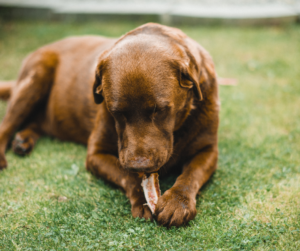Michael Baugh CDBC
It will stop you in your tracks, a dog hunkered over a prized item, snarling and growling. Worse if it’s our own dog. It’s even more frightening if the dog launches off the item to charge and bite us. They do that sometimes.
 Most of us have heard the term “resource guarding.” Dogs want to access and protect food, primarily. They will also guard things they find (tissues are a favorite), chew toys, dead things. The list goes on. Some dogs will guard valued sleeping spots. Others still guard people. Possession is key. Maintaining possession is where the conflict comes in.
Most of us have heard the term “resource guarding.” Dogs want to access and protect food, primarily. They will also guard things they find (tissues are a favorite), chew toys, dead things. The list goes on. Some dogs will guard valued sleeping spots. Others still guard people. Possession is key. Maintaining possession is where the conflict comes in.
Guarding resources is normal. We guard stuff, our cars, our homes. We have locks and alarm systems. Some of us are armed. None of us would take kindly to a passerby snatching a French fry from our plate at a restaurant. I sometimes call resource guarding evolutionarily adaptive. It keeps organisms alive long enough to pass on their genes.
The thing is, our dogs have plenty of food, lots of toys, comfy beds and kind people who love them. They have nothing to worry about. Still, the guarding shows up out of any rational context. It’s hard wired in even if it’s unnecessary.
How can we humans help?
Here’s what not to do. The answer is not to teach the dog who is boss and force the issue. That escalates the conflict. Escalation leads to bites. And I don’t think it’s about coercing the dog to let us reach and take an object from them. That can yield the same poor result.
Here’s what I recommend: teach a strong coming when called. Pick a cue. I use “Charlie Come!” Reinforce with high-value food every time you use the cue. Every time. If you’re just starting out, you can say the cue at a close distance, pause, and feed. Keep your promise. Every time I say “Charlie Come!” I pay with food. I never take a freebie (I reinforce with food every time he comes). If you want to learn more about this technique, you can contact me or watch the video “Really Reliable Recall.”
Let’s look at that hunkered, snarling dog again. What if we could simply call him to us and away from the guarded object? A well trained coming when called gives us that option. We aren’t chasing or scolding him. In fact, the best approach is to present ourselves as if the item doesn’t matter to us at all. We are calling our dog to us for a lovely treat, like we’ve done hundreds of times before. Because we trained with positive reinforcement, we are changing the subject altogether. Nothing to guard here.
When our dog comes to us, he has two acceptable options.
1) He can bring the item with him. He will drop it for the treat he always gets when he responds to the cue. We can choose to toss the treat away and recover the item. Or, if it’s his own bone or toy, we can treat him and give the item right back (nice training rep).
2) Alternatively, he can leave the item behind. We can toss his treat away and recover the item, or if we’ve taught a reliable “stay” cue, we can ask our dog to wait while we go get it.
This training process takes conflict out of the equation. We can call our dogs away from guarded spaces, too. We can even interrupt the guarding of people.
If your dog has bitten. Or if you think your dog is at risk of injuring a person or another animal, I recommend you work with a qualified Certified Dog Behavior Consultant familiar with using positive reinforcement to mediate aggressive behavior.
There is hope, even for dogs who seem particularly aggressive. No case is completely hopeless.
Michael Baugh specializes in aggressive dog training. He helps dog training clients all over North America.
